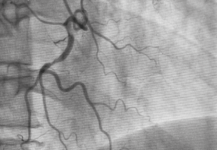The use of intravascular imaging helps improve diagnosis in situations where a conventional coronary angiography might not be conclusive. That is the case of patients with myocardial infarction with non-obstructive coronary artery lesions (MINOCA). The largest MINOCA cohort reported so far has shown 5%-7% prevalence. This pathology, initially considered benign, presents a remote mortality rate…
Primary vs Secondary Retrograde Approach in CTO: Differences
Successful chronic total occlusion procedures are on the rise, especially in high volume centers, seeing as they count on more sophisticated materials and different techniques, such the retrograde approach. However, the significant increase of success rate with this technique has also brought along an increase in associated complications. The aim of this study was to…
The Best of SOLACI-SOCIME 2022 Main Arena – Chronic Total Occlusions (CTO)
How to Choose the Best Approach in Chronic Total Occlusions, by Dr. Jean-Michel Paradis CTO are present in around 16 to 20% of patients with coronary artery disease who get a coronary angiography. CTO Percutaneous intervention has been on the rise, mainly due to equipment and technique advancement. During his presentation, Dr. Paradis mentioned the…
CTO: Trials vs. Real-World
Percutaneous coronary intervention of chronic total occlusions (CTO) is currently indicated for symptom improvement, as studies have inadequate randomization of data which hinders the assessment of hard outcomes. However, patient inclusion in randomized controlled trials has been challenging, especially for highly symptomatic and higher risk patients. This causes a selection bias in randomized studies on…
Progress-CTO Score: A Key New Tool to Plan CTO
Intervention of chronic total occlusions (CTO) through angioplasty (PCI) can cause complications, even in highly experienced centers. Plenty has been written on the probability of success for the treatment of CTOs using scores such as CL-SCORE, J-CTO, ORA, E-CTO, CASTLE-CTO, etc. (some of which are usually used when preparing these cases). However, besides estimating success…
Changes in Coronary Collateral Function Post CTO Intervention
In the last few years, we have seen significant growth of chronic total occlusion (CTO) percutaneous intervention, which has also been considered for patients with viable territory that remain symptomatic. Experienced centers present successful CTO intervention rates close to 90%, especially with a hybrid approach. However, it is still a complex procedure, and target vessel…
EuroPCR 2022 | The IMPROVED-CTO Trial
PCI success rate in chronic total occlusion (CTO), according to some registries, is below 80%. These failed revascularization procedures might lead to quality-of-life deterioration and shorter survival. This concern has driven the development of new techniques and technologies in an attempt to increase PCI success. Today, approximately 20% of CTOs are treated with a second…
Transfemoral vs Transradial Approach in the Percutaneous Treatment of CTO
Percutaneous treatment of chronic total occlusion (CTO) has traditionally been via the transfemoral approach (TFA). The use of the transradial approach (TRA) in complex coronary interventions has been increasing. A randomized study assessed the use of TRA vs TFA in complex PCI (58% CTO) and TRA saw favorable outcomes. The aim of this prospective, randomized,…
Can the Use of Intra Arterial Vasodilators Prevent Radial Artery Occlusion?
The incidence of post procedure radial occlusion (RAO) ranges from 1% to 12 % according to some studies. Different strategies to reduce RAO include the use of small caliber catheters, adequate anticoagulation and punction site care after procedure. Vasodilators are used to prevent radial spasm during procedure. However, using it after procedure should increase flow,…
EuroPCR 2021 | COLOR: Complex PCI via Transradial vs Transfemoral Approach
Treating total occlusions, complex bifurcations, grossly calcified lesions or left main lesions via transradial approach is associated with significant reduction in access-site bleeding or vascular complications vs transfemoral approach. This kind of procedures have been typically excluded from studies randomizing patients to transradial vs transfemoral approach. The COLOR study used the transradial bore-guiding catheter Glidesheath…
[APT Medical Sponsored Clinical Case] Bilateral Distal Transradial Access for Chronic Total Occlusion Recanalization and Multivessel Coronary Disease Percutaneous Intervention
Introduction Chronic total occlusion (CTO) represents the most challenging setting for percutaneous coronary intervention (PCI) and multivessel coronary disease (MCD) is often treated in a staggered manner and in a deferred procedure. Although transfemoral is one of the common access site, the transradial access (TRA) has been used with similar procedural success [1]. The distal…










